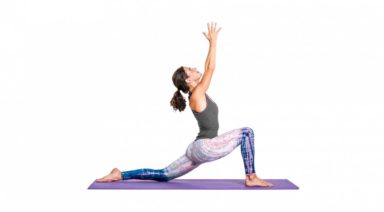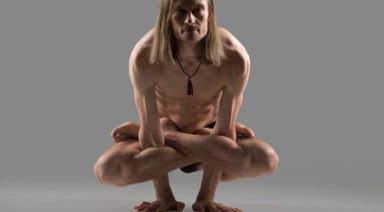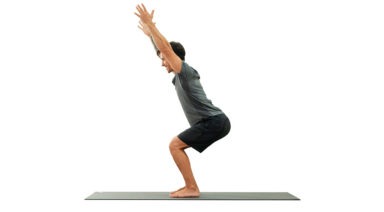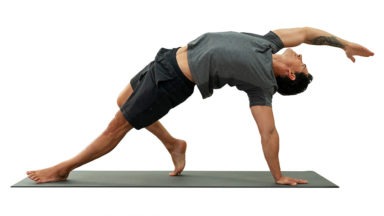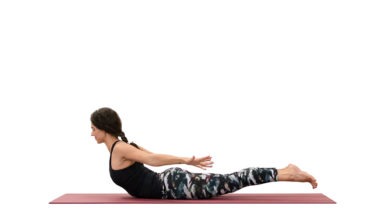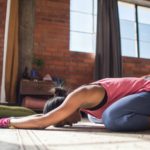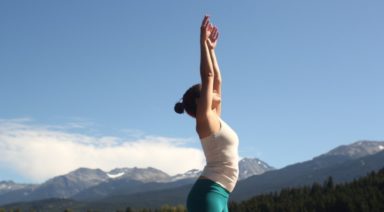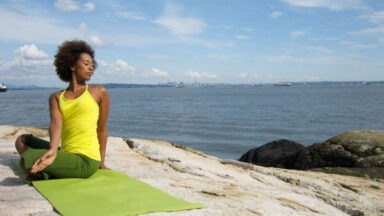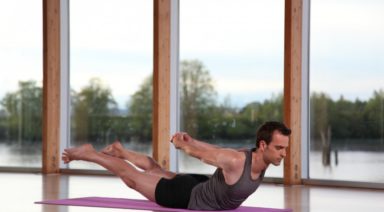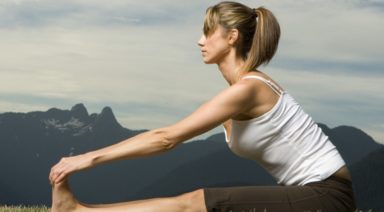10 Inspiring Quotes About Building a Home Yoga Practice
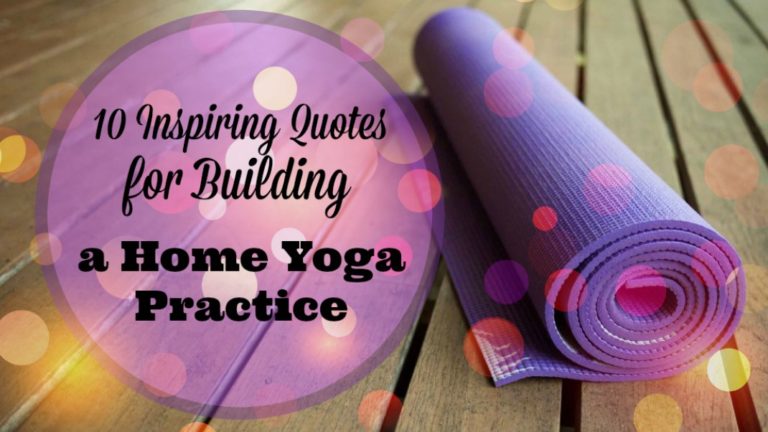
Starting (and actually sticking with) any new habit can be incredibly challenging, and yoga is no exception, especially when it comes to practicing yoga at home.
I’m continuously amazed at how diligent I am at sticking to my yoga practice when I have set days and times that I go to a studio with other people…and how horrible I am at sticking to my practice at home by myself!
Why can it be so difficult to do something that makes me feel so good?
Have you ever found yourself asking this same question? Well don’t be too hard on yourself, even experienced and world-renowned yoga teachers struggle when it comes to their home yoga practice. In a recent interview with Teachasana, Elena Brower admitted that one of the biggest challenges she’s faced as a yoga teacher has been practicing yoga at home.
“It took over a decade to develop a steady home practice, and it was only when I began studying Kundalini yoga that I found a regular time for myself.”
Elena Bower
What else are some of the world’s best-known yoga teachers saying when it comes establishing a consistent daily yoga practice?
Here are ten of my favorite quotes from top yoga teachers, which might just be what you need to get started with – and actually stick to – your home yoga practice.
- Experiment first, then be consistent.
“Start where you are: Don’t limit your experience with the idea that you need to meet some external goal. Let the internal and external training and churning and transformation happen authentically and in their own time. Show up: Stay present in your breath and be compassionate with yourself as you discover and play with your evolutionary edge. Be consistent: Establishing a practice is about finding a rhythm. Try practicing at different times of the day until you find the time where the rhythm of your daily energy naturally supports a steady practice.”
Shiva Rea
- Make your practice a conscious choice.
“One of the most dangerous words in the English language is “SHOULD.” We bury ourselves in shame and inadequacy when we listen to the “Should Bird” resting eagerly on our shoulder. Every time we use the word “should”, we are in effect saying that we are “wrong” and “not good enough.” As my Priestess, Ariel says, the “should bird” is “should-ing” all over us. The message is you were wrong, or you will be wrong if you don’t do whatever you think you “should” do.”
Ashley Turner
- Build a strong foundation by understanding basic techniques.
“In my dream world, students would know that there are techniques they need to understand before they approach a more challenging or fluid practice. That would mean either going to a very beginner-level class or an Iyengar class. For some students, that may feel too slow, but it’s providing the appropriate information that’s going to give them longevity in their practice.”
Seane Corne
- Start slow and discover your own inner teacher.
“Build a foundation with slower, more mild practices (like Hatha). Without a foundation, the rest of the structure cannot establish integrity and progress properly. Would you jump into a ten kilometer marathon without ever having done some form of training with running? NO! So why jump into an intermediate/advanced vinyasa class without first learning the basics (fundamental poses, elements of breathing, motor control and proprioceptive awareness, especially with deep stretching)? Most important, give yourself permission to find your inner teacher—external teachers offer a wealth of concepts, but this learning only has true value if it resonates with what your inner teacher expresses.”
Kreg Weiss
- Start with the poses you really enjoy.
“A lot of students in their minds set themselves up for failure in their home practice because they think that it has to replicate or repeat the exact same experience as a yoga class. You want to just develop a simple routine that is warm and satisfying to you. Start with poses you love! Maybe that will create enough momentum that you will then diversify your practice at home, but at first, start with what you love.”
Jason Crandell
- Ditch the idea that you need a special mat, clothes, or place to practice yoga.
“I wish that everyone knew that you didn’t need a 3 x 7 sticky mat to practice yoga. You can practice anywhere you wish for any amount of time—you can practice while you are standing in line at the grocery store, waiting in traffic, in a parking lot, on top of a mountain–there are so many places you can practice, and the best part is, it’s contagious!”
Chelsey Gribbon
- Approach your practice with openness and curiosity, rather than self-judgment or competitiveness.
“As you practice your first poses on your own, try to cultivate an attitude of playfulness and acceptance. Being present during your practice means allowing yourself to be aware of whatever physical sensations, emotions and thoughts are currently arising. Be creative and spontaneous. If you approach your practice with a sense of curiosity, rather than self-judgment or competitiveness, you will find it easier to motivate yourself to practice—and you’ll be more present when you do practice…At home, you learn to listen to what your body needs that day, move at your own pace, and develop intuition about what sequences or kinds of yoga poses you want and need to do most on any given day.”
Rodney Yee
- Allow for flexibility, in more than one sense of the word.
“I try to do something twice a day, sometimes it’s just a little bit. The place that my life happens to be will determine its intensity—anything from restorative to high intensity vinyasa. I try to be true to myself each day and see what I’m moved to do. I don’t have a mold or external blueprint that I follow, but in general I’m pulled toward vinyasa, heat-based movement, moving energy through my body. Rigid routines don’t really work well for me. I like fluid practice instead. My style is based on being safe and opening the body from a place that is protecting the joint system. I do a lot of creative sequencing, and I teach people my philosophy, “To thine own self be true.” You intuitively know what is right.”
Baron Baptiste
- Find a deeper sense of connection through reverence or ritual.
“The two most important elements of practice may be: consistency and reverence or ritual. These days I am fortunate enough to have a room in my home whose sole purpose is yoga and meditation. I enter it around the same time every day, about 5:30 A.M.–just as I have been doing for nearly thirty years. The teachings have long praised these quiet hours of the day, before sunrise, as the most productive time to practice. It’s also the time when the rest of my house is still asleep, which means no worldly duties will call or interrupt my practice–my process of remembering deep and abiding peace.
The first thing I do upon entering the room is light a flame and pay homage to it. The flame connects me to the source of life and the teachings. I think of my teacher(s), the teachings, and offer them my gratitude before I “do” anything. Once I establish that connection, I turn my awareness to my inner teacher to guide me as I move into postures and the whole of my practice.”
Rod Stryker
- Every time you fall off the bandwagon, jump back on!
“The critical element in meditation practice is beginning again. Everyone loses focus at times, everyone loses interest at times, and everyone gets distracted over and over again. What is essential, and also incredibly transforming, is realizing that we have the ability to begin again, without blaming or judging ourselves, without thinking we have failed, without losing heart, we can, and need to, constantly be beginning again.”
Sharon Salzberg
Put It Into Practice
Which of these quotes most resonates with you?
Spend some time, right now, thinking about how you might be able to integrate this advice into your life to begin—or more consistently stick with—your home yoga practice.
Share what you come up with in the comments section so that we all might inspire and benefit from one another!
SOLITUDE AND YOGA: DISCOVERING THE VALUE OF A HOME PRACTICE
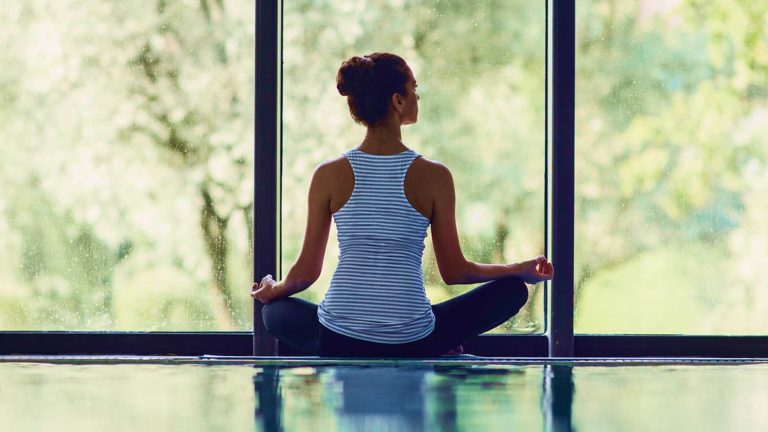
Many people say yoga has changed their lives, myself included. I started practicing in New York City, a place that has the potential be a yogi’s dream. There are expensive studios with a view, free yoga in the park, donation based studios, and celebrity instructors. You can find Kundalini, Bikram, [Ashtanga]/style/ashtanga-yoga}, power yoga, etc. You name it and New York probably has it. It’s something of a phenomenon there, often marketed as the preferred method of escape from the crazed city lifestyle.
I’d be lying if I said I didn’t enjoy my time in the fancy studios. I did. I looked forward to drinking my eight dollar green juice while heading to the studio that I paid an exorbitant amount of money to every month. The lululemon was on, toenails painted, and hair in a proper ponytail. In class I would try my hardest to nail that handstand, to remain in crow for longer than five seconds, and to ensure my stomach was constantly sucked in. At times I pushed my body passed where it was ready to go. While I knew this was a result of my vanity and my own issues, and not the fault of the studio, I was missing the most important aspect of yoga. I lacked the connection to self, the willingness to let go and just be and observe. While I knew there were people in my class who were able to block the outside world out (and I salute them for that), I also knew there were others who had experienced, and continued to feel the same fears and discomfort, that I felt.







